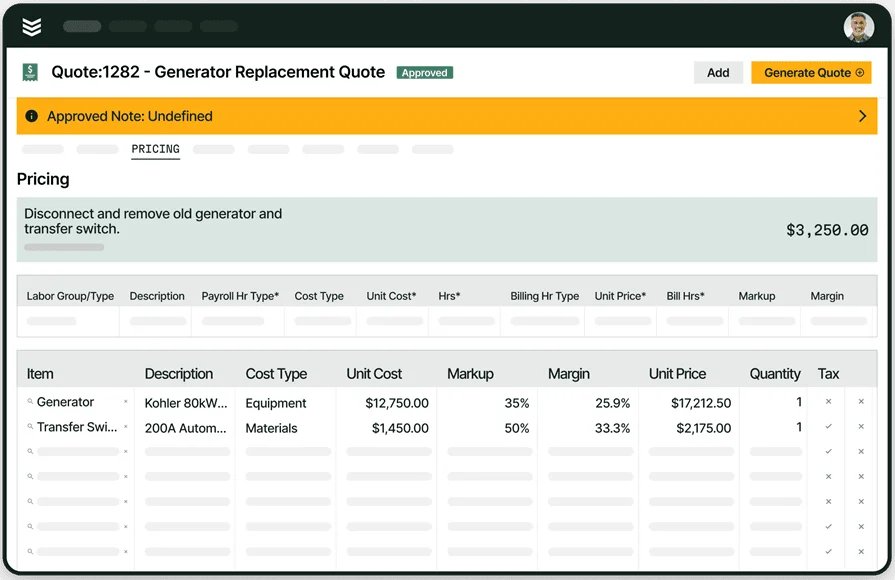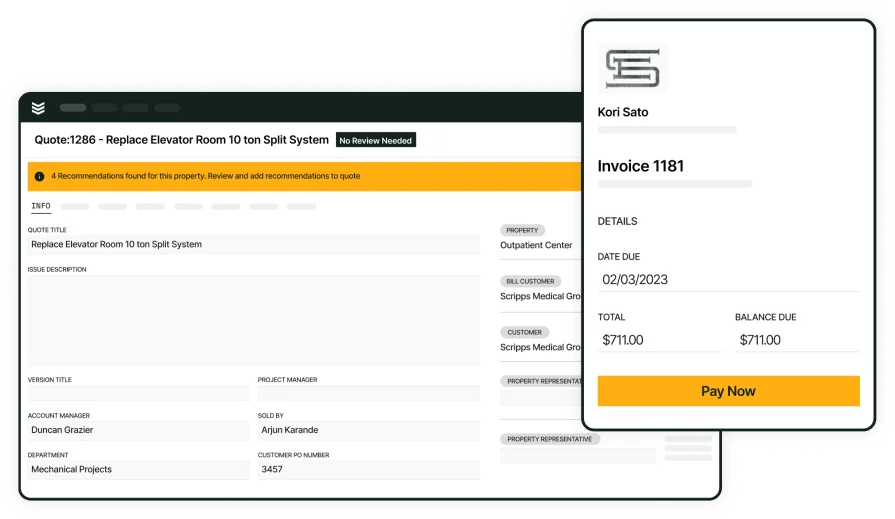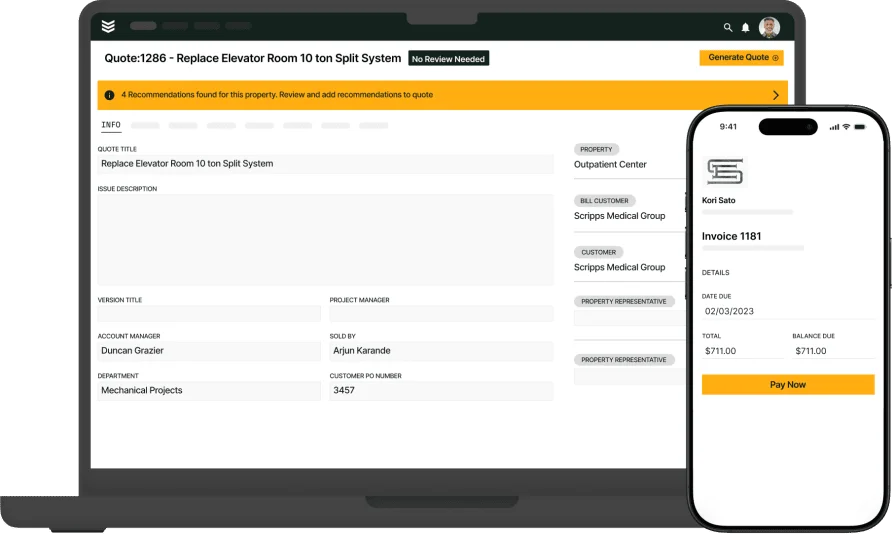Managing an electrical contracting business means juggling estimates, tight schedules, and protecting your profit on every job. If your crew still leans on old spreadsheets, printed price books, or calls the office for pricing, mistakes happen—and revenue gets lost. An electrical pricing app gives your team accurate, reliable numbers right where the work happens.
These apps put pricing tools directly into your electricians' hands. Labor, materials, service packages—it’s all right there on-site. Across the electrical industry, contractors are using pricing apps to eliminate guesswork, speed up approvals, and keep jobs moving from estimate to invoice without delays.
Here’s what this guide will cover:
- Choosing the right electrical pricing app for your team
- 5 key features to look for in an electrical pricing app
- Types of electrical pricing apps
- 8 best electrical pricing apps for contractors and teams
- 7 benefits of electrical pricing apps for contractors
- 4 important electrical pricing app FAQs answered
Plenty of apps promise quick estimates and simple quoting. The challenge is finding one that matches how your electricians work out in the field. Let’s look at how to choose an electrical pricing app that keeps your crew efficient—and locks in solid quotes every time.
Choosing the right electrical pricing app for your team
An electrical pricing app should take the guesswork out of quoting. Whether your crew handles residential installs, large commercial systems, or specialized electrical work, the goal stays the same—build fast, accurate estimates that make sense in the field. Your techs don’t have time to wrestle with complicated software while standing in front of a service panel or calculating wire runs on the fly. The best electrical pricing apps help them get numbers locked in quickly so they can focus on the work.
Before committing to any platform, it’s worth breaking down a few key areas to see how well it lines up with how your team actually works.
- Workflow fit – Will this app work with how your electricians quote, schedule, and invoice? Can it handle both service calls and project-based work? Does it plug into your current systems, or require a full system overhaul?
- Field usability – Can your techs easily use the app on a tablet or phone? Does it allow quick searches for materials, labor rates, and parts while they’re standing on the jobsite? Will new hires pick it up without hours of training?
- Customer experience – Does the app allow you to send clean, professional quotes to customers while still on-site? Can customers review pricing breakdowns, approve work digitally, and receive immediate documentation?
- Scalability – Will this app support you as your company grows? Does it offer multi-user access for dispatch, office staff, and field techs? Can it handle multiple crews, projects, and job tracking without breaking down?
- Features – Does it include flat-rate pricing options? Can it calculate labor and materials automatically? Does it let your team convert estimates to invoices quickly? Can it connect with your CRM, inventory system, or payment processors? Which features deliver real value to your crew and bottom line?
Once you’ve narrowed down what your electricians need most, the next step is digging into the features that make the best electrical pricing apps stand out. The following section breaks down five key capabilities every electrical team should keep in focus.
5 key features to look for in an electrical pricing app
The best electrical pricing apps do more than handle numbers—they keep jobs moving, help techs quote accurately in the field, and protect your margins without slowing anyone down. From quoting to invoicing, these tools make sure your pricing stays consistent whether your crew is wiring a new panel, replacing outdated service equipment, or quoting a large commercial install.
Here are the features that separate a decent pricing app from one that actually fits your electrical service team.
1. Field invoicing and payments
Electrical service jobs move fast, and so should the billing. The best electrical pricing apps let your crew convert approved quotes into invoices on-site with electrical field service invoicing software and collect payments instantly using electrical service payment solutions. This keeps your cash flow steady and eliminates billing delays.
For instance, after installing a new subpanel upgrade for a commercial client, your technician finalizes the job, generates the invoice directly from the pricing app, and accepts the payment before stepping off the property. There’s no waiting for back-office processing or chasing down unpaid balances days later.
2. Real-time scheduling and dispatching
Once a quote is approved, the next step is getting the job assigned fast. The best electrical pricing apps connect directly with both electrical scheduling software and dispatch software, allowing your team to slot in jobs based on availability, skillset, and location—without juggling phone calls or spreadsheets.
For example, after your estimator secures approval for a panel replacement at a manufacturing facility, dispatch instantly sees the open slot on the schedule, assigns the nearest qualified tech, and routes them to the job. The customer stays happy, your schedule stays full, and your pricing app keeps the entire process moving without missing a beat.
3. Field-ready mobile access
Electricians need full pricing access at the job site without having to call the office. That’s where a technician mobile app makes all the difference, giving your crew labor rates, material costs, and service history directly from their tablets or phones. Consider a tech troubleshooting power loss in a data center. Once the faulty wiring is located, the tech quickly pulls the pricing catalog, calculates labor hours, and builds the estimate right there—no paperwork, no delays, and no lost upsell opportunities.
4. Customer history and CRM integration
The best electrical pricing apps integrate with your CRM system for electrical contractors, so every quote reflects customer history, previous repairs, and existing equipment data. This allows techs to create more accurate estimates on-site.
Let’s say your team arrives for scheduled maintenance on a facility where they recently installed switchgear upgrades. The tech pulls up detailed service history, quickly sees previous work completed, and builds a quote that reflects only what still needs attention—without redundant pricing.
5. Real-time reporting and pricing oversight
Tracking which quotes close, which stall, and where pricing adjustments are needed helps fine-tune your business. The best electrical pricing apps include reporting tools that give you live data on estimate conversion, revenue trends, and pricing consistency across your entire team.
Imagine reviewing reports shows your service team is consistently underbidding complex panel upgrades. You can quickly adjust pricing templates inside the app to better reflect true labor hours and material costs going forward, protecting your profit margins.

Leveled up electrical estimating
Accurate estimates to land jobs and get paid faster.
Other notable features to look for in an electrical pricing app
While the core features do most of the heavy lifting, several additional tools can make the best electrical pricing apps even stronger. These features help fine-tune how your team prices, manages, and tracks work—giving your office and field techs extra support without complicating daily operations.
- Service agreement management – For contractors handling ongoing maintenance contracts, service agreement tools make it easier to apply consistent pricing to recurring jobs and renewals.
- Pipeline and sales tracking – With pipeline management software, your team can monitor open quotes, track approval statuses, and follow up on pending jobs to keep the sales cycle moving.
- Time tracking integration – Accurate labor costing starts with solid time tracking. Time tracking software feeds real-time labor hours directly into pricing estimates, preventing underbidding and protecting profit margins.
- Fleet management visibility – Knowing where your vehicles are and how they’re performing supports both dispatch and pricing accuracy. Electrical fleet management tools give office staff insights into vehicle location, fuel usage, and service needs.
Now that you’ve seen both the core and supporting features that make the best electrical pricing apps valuable, the next step is understanding how these apps are structured. Not every contractor needs the same type of setup. In the next section, we’ll break down the different types of electrical pricing apps and how each one fits specific field service operations.

Level up your electrical pricing
Check out the electrical service work toolkit for leading strategies.
Types of electrical pricing apps
The way an electrical pricing app is built plays a huge role in how well it fits your business. Some tools give your techs full flexibility out in the field, while others focus on office-level control. Whether your team handles residential service calls, commercial builds, or multi-site maintenance, knowing the different types of apps helps you pick the setup that works best for how your electricians operate every day.
- Cloud-based: These apps store pricing data, estimates, customer details, and job updates online, making it easy for your field teams to access the information they need from any location. For mobile electrical service crews that work across multiple job sites, cloud-based field service management software keeps everything connected and up to date, as long as there’s a stable internet connection.
- On-premise: Installed on local servers, on-premise systems give you full control over your data and may appeal to companies with strict IT security policies or limited internet access. The tradeoff is less flexibility for mobile crews, since these systems often struggle to sync smoothly with field apps or offer real-time updates between office and job site.
- Mobile: Mobile-first pricing apps are built specifically for your techs in the field. These apps allow electricians to build estimates directly on tablets or smartphones while standing at the job site. They work best when fully integrated with back-office systems—without that connection, you risk losing real-time syncing, job tracking, or instant approvals.
- All-in-one field service platforms: These combine pricing, dispatch, CRM, invoicing, reporting, and scheduling into a single system. For electrical contractors looking for full visibility across every stage of a job, an electrical field service management platform offers true end-to-end control. Everything from quoting to payment stays connected, which keeps projects on track and back-office work streamlined.
Each type of electrical pricing app serves a different need depending on how your business operates. Next, let’s break down the best electrical pricing apps contractors and teams are using right now—and what makes each one stand out.
8 best electrical pricing apps for contractors and teams
Every electrical shop operates a little differently, so the electrical pricing app you choose needs to fit how your team works every day. Some apps are designed for quick quoting directly in the field, while others focus more on project bidding or office management. Below, we break down the top options—what they offer, where they may fall short, and who they fit best.
1. Best for commercial: BuildOps
BuildOps delivers a strong advantage for commercial electrical contractors managing complex quotes, multi-phase installs, and ongoing service work. It helps keep both field and office teams connected while giving precise control over pricing, quoting, invoicing, and job management across every stage. For electrical companies juggling large projects, recurring service contracts, and high-volume quoting, BuildOps helps deliver consistent pricing accuracy and faster approvals. However, BuildOps may be too comprehensive for very small shops that only need basic quoting tools without full-service management.
App type: Cloud-based, mobile-friendly, all-in-one field service platform
How Pricing Works: BuildOps uses a custom-quoted pricing model tailored to the size and scope of each contractor’s business. You'll need to schedule a demo for detailed pricing.
Features Beyond Pricing: BuildOps offers full dispatching, time tracking, CRM, reporting, pipeline management, invoicing, project management, and quoting workflows—all fully integrated into one system for seamless job management.
What Sets It Apart for Commercial: Built specifically for commercial electrical contractors, BuildOps handles multi-site clients, detailed pricing for large-scale work, recurring maintenance agreements, and high-ticket estimates without breaking workflows.

Give BuildOps a Try
We give electrical contractors what they need to price jobs with confidence.
2. Best for small to mid-sized businesses: Jobber
Image Source: Jobber
Jobber gives smaller electrical service companies a simple way to handle quoting, scheduling, and invoicing all in one easy-to-use platform. Its clean interface works well for teams that want to get digital without needing a complex system. However, it may not be ideal for larger electrical companies that require advanced customization, detailed reporting, or more robust field service management.
App type: Cloud-based, web-based solution
How Pricing Works: Plans start at $29/month for one user, and scale depending on feature levels.
Features Beyond Pricing: Jobber includes calendar scheduling, client communications, invoice tracking, mobile access, and automated follow-ups to help keep smaller teams organized and get paid faster.
What Sets It Apart for SMBs: Well-suited for 1–10 technician shops looking for fast quoting tools and basic operations management without a steep learning curve.
3. Best for general contractors: STACK
Image Source: STACK
STACK focuses heavily on preconstruction estimating, making it ideal for electrical contractors that bid alongside general contractors on commercial or industrial projects. Its digital takeoff tools, markup capabilities, and plan management help streamline detailed bid packages. However, STACK isn’t a good fit for service contractors who need real-time pricing tools for field work or ongoing electrical service jobs.
App type: Cloud-based
How Pricing Works: Free trial available; paid plans start around $2,999/year for one user
Features Beyond Pricing: STACK includes takeoffs, plan markups, collaborative bidding, document sharing, and detailed pricing breakdowns to simplify large-scale estimating.
What Sets It Apart for General Contractors: Ideal for blueprint-based pricing, especially for commercial build-outs or major construction projects involving complex electrical scopes.
4. Best for residential: ServiceTitan
Image Source: ServiceTitan
ServiceTitan is widely used by residential electrical contractors who need a full-service quoting, scheduling, and customer management solution. Its flat-rate pricing tools and mobile quoting features help techs present clear options to homeowners during service calls. However, larger commercial shops may find it limiting, as it’s primarily focused on residential workflows and lacks flexibility for complex commercial pricing structures.
App type: Cloud-based, web-based solution
How Pricing Works: Custom pricing based on company size and selected features
Features Beyond Pricing: Includes job costing, appointment scheduling, automated customer reminders, follow-ups, flat-rate pricing libraries, and mobile access for in-field quoting and upsells.
What Sets It Apart for Residential: Designed for residential service work with real-time quoting features that help techs close sales while still on-site.
5. Best for independent contractors: Joist
Image Source: Joist
Joist works well for solo electricians or small independent contractors who want a lightweight app to create estimates, send invoices, and collect payments quickly on-site. Its simple mobile interface allows contractors to produce polished quotes without heavy back-office support. However, Joist may not be the best fit for companies managing multiple crews or needing advanced scheduling, job tracking, or dispatching features.
App type: Cloud-based, mobile-first
How Pricing Works: Free version available; Pro plans start at roughly $13/month
Features Beyond Pricing: Customizable templates, digital approvals, simple invoicing, client management, and built-in payment processing.
What Sets It Apart for Independent Contractors: Built for one-person shops that need fast quoting and professional-looking documents without added complexity.
6. Best for ease of use: Service Fusion
Image Source: Service Fusion
Service Fusion focuses on making quoting and job management simple for electrical contractors who want to move off paper and spreadsheets quickly. Its clean interface helps field and office teams stay organized with flat-rate pricing, scheduling, and invoicing tools. However, larger commercial operations may outgrow its limited customization and reporting capabilities over time.
App type: Cloud-based, web-based solution
How Pricing Works: Pricing starts at $126/month for the base plan
Features Beyond Pricing: Supports scheduling, invoicing, payment processing, flat-rate pricing, mobile access, and GPS tracking for field crews.
What Sets It Apart for Ease of Use: Great for small teams that need fast onboarding, simple quoting tools, and clear workflows without hours of training.
7. Best for electrical business owners and designers: Field Promax
Image Source: Field Promax
Field Promax serves electrical businesses that balance both quoting and workflow design. Its customization options and template-driven features help owners manage pricing and scheduling while keeping jobs organized. However, compared to newer platforms, its interface can feel dated and may require additional training to get fully comfortable.
App type: Cloud-based, web-based solution
How Pricing Works: Plans start at around $49/month per user
Features Beyond Pricing: Includes job scheduling, estimating, approvals, team management, and flexible workflow templates designed for both service and install work.
What Sets It Apart for Owners and Designers: Offers flexible pricing templates and workflow management for businesses that handle both design-build and service work.
8. Best for specialty contractors: Zuper
Image Source: Zuper
Zuper targets electrical contractors handling specialized services that require multi-phase jobs, documentation, or regulatory compliance. Its customization features, mobile workflows, and integration options make it highly adaptable. However, smaller service shops may find its wide feature set overwhelming if they don’t need deep customization or integration layers.
App type: Cloud-based, web-based
How Pricing Works: Custom pricing based on company size, needs, and usage
Features Beyond Pricing: Includes job routing, inventory tracking, job status updates, service-level agreements, compliance checklists, and integrations with platforms like Zendesk and QuickBooks.
What Sets It Apart for Specialty Contractors: Designed for contractors managing complex, regulated, or multi-stage service work with layered pricing and job requirements.
7 benefits of electrical pricing apps for contractors
An electrical pricing app doesn’t just help build quotes—it shapes how your entire operation functions day-to-day. From faster approvals to stronger customer relationships, these apps simplify the work your techs and office staff juggle every single day.
1. Faster quote turnaround on every job
With everything priced out inside the app, techs can generate professional estimates right at the job site. No more waiting on office approvals or flipping through spreadsheets, which means quotes get into customers' hands faster and jobs move forward sooner. Faster turnaround helps prevent jobs from sitting idle in the pipeline, allowing your team to close deals before competitors even submit their estimates.
2. Cleaner invoicing and quicker payments
By connecting pricing directly into invoicing, electrical pricing apps eliminate missed charges and help you collect payments sooner. Every approved quote flows straight into an invoice, reducing paperwork delays and errors that slow cash flow. As a result, you keep accounts receivable under control and avoid the cash crunch that often comes from slow billing cycles—a huge win for service contractors balancing multiple projects. Contractors looking to tighten this process often turn to resources like this electrical contractor invoicing guide to structure billing more efficiently.
3. More accurate labor and material pricing
Instead of guessing or manually entering costs, your pricing app pulls real labor hours, parts, and service rates into each estimate. This keeps your pricing sharp and protects profit margins. Over time, having these accurate cost inputs helps you refine your estimating strategies based on real job data, ensuring each new quote reflects your actual profit goals rather than rough estimates. Understanding how these numbers work together is critical, and many contractors reference materials like this electrical cost estimating guide to dial in their pricing models.
4. Consistent pricing across every technician
When everyone prices from the same database, your team delivers consistent quotes no matter who’s on the job. This helps avoid pricing disputes, missed charges, or techs unintentionally underbidding complex work. Standardizing pricing also protects your business from relying on "gut feel" quoting, ensuring that even newer techs can confidently build accurate proposals without second-guessing themselves.
5. Smoother handling of large install jobs
For electrical contractors handling full installations or complex projects, pricing apps help organize multi-phase labor, equipment costs, and scheduling into one system. These apps give project managers a clearer view of total job costs from start to finish, making it easier to control budgets as projects evolve. Tools like this electrical installation estimating and costing resource offer solid frameworks for building these larger estimates accurately.
6. Stronger customer management with CRM integration
When pricing apps sync with your CRM, your team sees service history, past quotes, and customer preferences right inside the estimate. This allows for better upsell conversations, faster approvals, and smarter follow-ups. It also helps build long-term customer trust, since clients appreciate seeing consistent service history and transparent quoting tied to previous work performed. Guides like this one on the best CRM for electrical contractors help many shops fine-tune how customer data and pricing work together.
7. Smarter estimating with AI-powered tools
As AI becomes part of estimating workflows, pricing apps are starting to include predictive tools that suggest pricing adjustments, flag missing line items, or forecast labor based on historical data. This reduces human error and speeds up estimating, especially for complex jobs that would otherwise require multiple revisions. This type of AI electrical estimating software gives contractors an edge in both speed and pricing accuracy.
4 important electrical pricing app FAQs answered
Contractors know that pricing can make or break a job. For electrical contractors and field techs managing estimates in fast-paced environments, having the best electrical pricing apps in place helps eliminate errors, speed up quotes, and protect profit margins from the office to the field. Below, we break down the key questions electricians are asking when evaluating these tools for their daily operations.
1. What is an electrical pricing app?
An electrical pricing app helps contractors create accurate job estimates, apply consistent flat-rate or custom pricing, and turn approved quotes directly into invoices. They centralize labor rates, material pricing, and service bundles so your crew can build error-free quotes while standing on-site.
Beyond estimating, most electrical pricing apps connect to CRM systems, dispatching, and payment processing, streamlining everything from quoting to invoicing. They’re designed to make quoting fast, protect margins, and give electricians and office staff a pricing system that works wherever the job takes them.
2. How do pricing apps work for electrical contractors?
Electrical pricing apps sync your team’s quoting, invoicing, and billing tasks into one connected system that eliminates manual work and double entry. Your electricians pull up service pricing, parts lists, and labor rates on the job site and can build complete quotes on the spot. Here’s how it typically plays out:
- Access pricing and service catalogs instantly from the field
- Build consistent, template-driven estimates on-site
- Convert estimates into invoices with a few taps
- Sync with your CRM to pull up customer job history
- Attach photos, site notes, and repair recommendations directly to quotes
- Capture digital approvals and customer signatures
- Tie invoices to job records automatically for back-office tracking
- Collect payments on the spot or send invoices for later billing
Whether it’s a quick panel replacement or a multi-phase facility upgrade, electrical pricing apps keep your quotes consistent, fast, and easy to manage from anywhere.
3. Is the cost of pricing apps worth it for electricians?
In almost every case, yes. The investment in the best electrical pricing apps pays for itself by eliminating missed charges, tightening up quoting workflows, and shortening invoice collection times. For contractors struggling with inconsistent quotes or long approval delays, these apps often recoup their cost after just a few jobs.
By removing guesswork from estimating, helping close jobs faster, and reducing errors that cost you margin, pricing apps create better financial control. The cost of doing nothing is often far more expensive in the long run.
4. Best practices for implementing an electrical pricing app
Rolling out a pricing app takes more than just installing software—it requires planning and buy-in from your team. Here are ten proven best practices electrical contractors should follow to get the most value from their pricing app:
- Start with your current workflow – Identify bottlenecks in your quoting and invoicing process
- Get techs involved early – Gather feedback from field electricians who’ll use the app daily
- Standardize your pricing catalog – Clean up labor rates, parts lists, and service packages
- Train in real scenarios – Use live job examples, not made-up test cases, during training
- Use mobile devices – Ensure techs can easily access the app in the field
- Connect to your CRM – Link customer histories to every quote for smarter follow-ups
- Track estimate-to-invoice conversion – Monitor how quotes move through your system
- Review weekly – Check adoption rates, quoting accuracy, and team feedback regularly
- Fine-tune labor calculations – Adjust labor hours and pricing templates based on real field data
- Keep leadership involved – Ensure business owners and managers stay engaged in the rollout
Building strong habits from the start helps your electricians get comfortable quoting confidently and using the system daily.
The best electrical pricing apps do far more than just crank out estimates. For contractors and field techs, these tools become the backbone of how work gets priced, approved, scheduled, and invoiced — keeping jobs moving and margins protected without slowing crews down. Whether you’re wiring multi-phase commercial builds or managing hundreds of service calls a month, having a pricing system that works where your electricians work — in the field — eliminates costly mistakes and keeps every estimate locked into real numbers.
For commercial contractors handling complex jobs across multiple teams, having all those quoting, scheduling, invoicing, and reporting tools inside one system simplifies the entire process. That’s where a full-service platform like BuildOps makes a difference, connecting your pricing directly to every stage of the job cycle.

See how BuildOps fits your team
Learn how we help electrical contractors price jobs with precision.









